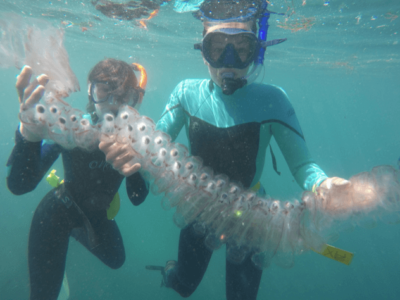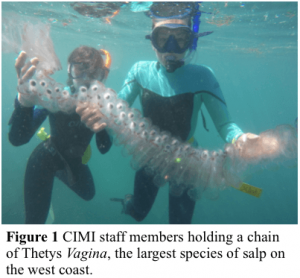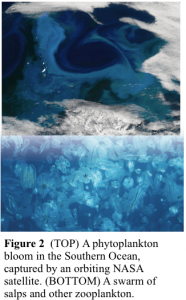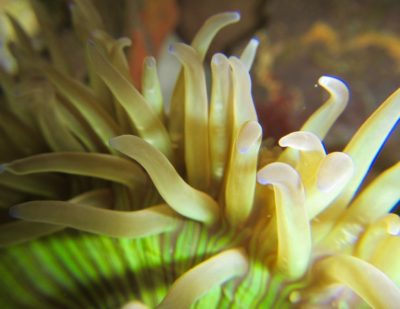
Have you ever been walking along the beach or kayaking through the ocean and spotted what appeared to some weird plastic bag looking jellyfish-like thing? Have you ever thought, “What on earth is that?” Well that is a salp and it is not a jellyfish (Figure 1). It is a tunicate, which is in the phylum Chordata. The very same phylum that you and I are in. That means that that strange transparent gelatinous sack has more in common, evolutionarily speaking, with us than it does with its jellyfish doppelgängers.
 As members of the phylum Chordata, most tunicates have a tail, notochord, nerve cord, gills, simplified eyes, and even a brain. But only during their larval stage. As adults, they lose most of the features that make them like other vertebrates. Tunicates, named so because of their tunic-like outer layer, include sessile sea squirts and sea porks as well as free swimming and planktonic salps, doliolids and pyrosomes.
As members of the phylum Chordata, most tunicates have a tail, notochord, nerve cord, gills, simplified eyes, and even a brain. But only during their larval stage. As adults, they lose most of the features that make them like other vertebrates. Tunicates, named so because of their tunic-like outer layer, include sessile sea squirts and sea porks as well as free swimming and planktonic salps, doliolids and pyrosomes.
These seemingly simple jello sacks actually do a lot. Salps are one of the most energy efficient organisms out there. Not only do they eat at the same time as they swim, their waste has also been linked to the carbon cycle and may even impact climate change. They move by jet propulsion, sucking in water through their inhalant siphon and pushing it out their exhaling siphon by squeezing the tunic. As the water travels through their gelatinous bodies, it passes through their pharynx, where a mucus net and beating cilia filter out plankton and organic matter of all sizes. In fact, they consume particles spanning four magnitudes in size. That’s the equivalent of us eating everything from a mouse to a horse, according to research conducted bu the Woods Hole Oceanographic Institution. This allows them to survive in the open ocean, where food is often scarce. Their ability to eat nearly everything that passes through them also gives them an important role in the carbon cycle.
 Salps are found in every ocean but are often concentrated near the Antarctic where there favorite snack, phytoplankton, blooms (Figure 2). Salps can devour entire blooms by rapidly cloning themselves and forming huge chains. Salps, with can live for weeks or months, start off as an individual that reproduces asexually, making multiple genetic clones that then form long chains, wheels and other structures. Individuals within the chains then reproduce sexually with other chains through external fertilization processes. Salps can produce thousands, millions of other salps at these phytoplankton blooms. Imagine the scene: a slow motion feeding frenzy with salps popping into existence like Imperial Star Destroyers coming out of hyperspace. You can almost hear the haunting music of the “Imperial March” in the background as these salp clones attack, wrecking havoc on the defenseless phytoplankton.
Salps are found in every ocean but are often concentrated near the Antarctic where there favorite snack, phytoplankton, blooms (Figure 2). Salps can devour entire blooms by rapidly cloning themselves and forming huge chains. Salps, with can live for weeks or months, start off as an individual that reproduces asexually, making multiple genetic clones that then form long chains, wheels and other structures. Individuals within the chains then reproduce sexually with other chains through external fertilization processes. Salps can produce thousands, millions of other salps at these phytoplankton blooms. Imagine the scene: a slow motion feeding frenzy with salps popping into existence like Imperial Star Destroyers coming out of hyperspace. You can almost hear the haunting music of the “Imperial March” in the background as these salp clones attack, wrecking havoc on the defenseless phytoplankton.
As they consume the phytoplankton, they produce dense fecal pellets that rain carbon down on the deep sea. This acts as an effective carbon sink that removes carbon from the ocean surface and traps it a depth for hundreds of years. Thus allowing the upper ocean to accumulate more carbon from the atmosphere, mitigating the anthropogenic rise in carbon-dioxide in the atmosphere.
Sources:
https://www.nytimes.com/2017/08/04/science/salps-chains.html
https://goodheartextremescience.wordpress.com/2010/01/27/meet-the-amazing-salp/
http://planktonchronicles.org/en/episode/salps-exploding-populations/
https://www.nsf.gov/news/news_summ.jsp?cntn_id=117484
Images:
https://teara.govt.nz/en/photograph/5133/a-swarm-of-zooplankton


